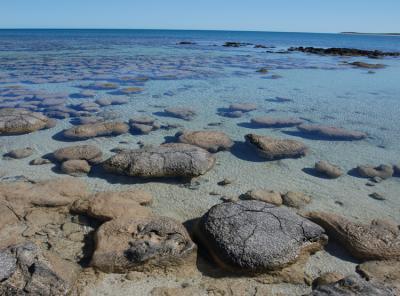Stromatolites, "layered rocks", are structures made of calcium carbonate and shaped by the actions of photosynthetic cyanobacteria and other microbes that trapped and bound grains of coastal sediment into fine layers. They showed up in great abundance along shorelines all over the world about 3.5 billion years ago and remain the earliest visible manifestation of life on Earth.
The growing bacterial community secreted sticky compounds that bound the sediment grains around themselves, creating a mineral "microfabric" that accumulated to become massive formations. Stromatolites dominated the scene for more than two billion years, until late in the Proterozoic Eon when they underwent a widespread disappearance.Stromatolites can still be found today so they are not extinct. But why the drastic decline? A new study says that widespread disappearance may have been driven by single-celled organisms called foraminifera.
"Around 1 billion years ago, their diversity and their fossil abundance begin to take a nosedive," said Woods Hole Oceanographic Institution geobiologist Joan Bernhard, lead author of the study. "All over the globe, over a period of millions of years, the layered formations that had been so abundant and diverse began to disappear. To paleontologists, their loss was almost as dramatic as the extinction of the dinosaurs millions of years later, although not as complete: Living stromatolites can still be found today, in limited and widely scattered locales, as if a few velociraptors still roamed in remote valleys.
The researchers thought foraminifera might have played a role. Foraminifera (or "forams," for short) are protists, the kingdom that includes amoeba, ciliates, and other groups formerly referred to as "protozoa." They are abundant in modern-day oceanic sediments, where they use numerous slender projections called pseudopods to engulf prey, to move, and to continually explore their immediate environment.
While the extinction of the dinosaurs has largely been explained by the impact of a large meteorite, the crash of the stromatolites remains unsolved. Another puzzle is the sudden appearance in the fossil record of different formations called thrombolites ("clotted stones"). Like stromatolites, thrombolites are produced through the action of microbes on sediment and minerals. Unlike stromatolites, they are clumpy, rather than finely layered.
It's not known whether stromatolites became thrombolites, or whether thrombolites arose independently of the decline in strombolites. Hypotheses proposed to explain both include changes in ocean chemistry and the appearance of multicellular life forms that might have preyed on the microbes responsible for their structure.
Despite their known ability to disturb modern sediments, the possible role of foraminifera in the loss of stromatolites and appearance of thrombolites had never been considered, the researchers say.

Stromatolites, once widespread in coastal areas, now thrive in just a few locations in the tropical Atlantic and Indian Oceans and in some very salty lakes. The formations see here are near Shark Bay on the western coast of Australia. The cyanobacteria in stromatolites live very near the surface of the rock, where they can receive the sunlight they need to photosynthesize. Credit: Virginia Edgcomb, Woods Hole Oceanographic Institution
The researchers examined modern stromatolites and thrombolites from Highborne Cay in the Bahamas for the presence of foraminifera. Using microscopic and rRNA sequencing techniques, they found forams in both kinds of structures. Thrombolites were home to a greater diversity of foraminifera and were especially rich in forams that secrete an organic sheath around themselves. These "thecate" foraminifera were probably the first kinds of forams to evolve, not long (in geologic terms) before stromatolites began to decline.
"The timing of their appearance corresponds with the decline of layered stromatolites and the appearance of thrombolites in the fossil record," said Woods Hole Oceanographic Institution microbial ecologist Virginia Edgcomb, a co-author on the paper. "That lends support to the idea that it could have been forams that drove their evolution."
The researchers then created an experimental scenario that mimicked what might have happened a billion years ago.
"No one will ever be able to re-create the Proterozoic exactly, because life has evolved since then, but you do the best you can," Edgcomb said. They started with chunks of modern-day stromatolites collected at Highborne Cay, and seeded them with foraminifera found in modern-day thrombolites. Then they waited to see what effect, if any, the added forams had on the stromatolites.
After about six months, the finely layered arrangement characteristic of stromatolites had changed to a jumbled arrangement more like that of thrombolites. Even their fine structure, as revealed by CAT scans, resembled that of thrombolites collected from the wild. "The forams obliterated the microfabric," said Bernhard.
That result was intriguing, but it did not prove that the changes in the structure were due to the activities of the foraminifera. Just being brought into the lab might have caused the changes. But the researchers included a control in their experiment: They seeded foraminifera onto freshly-collected stromatolites as before, but also treated them with colchicine, a drug that prevented them from sending out pseudopods. "They're held hostage," said Bernhard. "They're in there, but they can't eat, they can't move."
After about six months, the foraminifera were still present and alive—but the rock's structure had not become more clotted like a thrombolite. It was still layered.
The researchers concluded that active foraminifera can reshape the fabric of stromatolites and could have instigated the loss of those formations and the appearance of thrombolites.
Published in the Proceedings of the National Academy of Sciences.





Comments